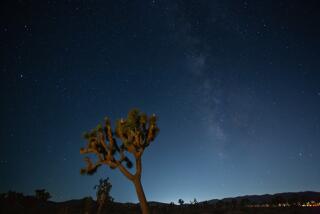Through the Shutter : Get Good Aerial Pictures With a Simple Camera
- Share via
We accept manned flight as a way of life; it is the primary form of international travel. But flight is also for recreation and sightseeing. Tourists ride in helicopters over the Statue of Liberty, the Grand Canyon and the Golden Gate Bridge. Naturally, many want to use their cameras to record the world from a bird’s-eye view.
Aerial photography does not require elaborate equipment or special film. Excellent pictures can be taken from the air with the standard SLR (single lens reflex) camera with black and white, color print film or slide film and a normal lens.
A few rules and guidelines, however, can help you to get better aerial pictures. You will need to carry your camera and film in a shoulder bag when boarding the aircraft. The X-ray machines at the security checkpoints (within the United States) are not strong enough to damage or fog film, but I still ask that my film be hand-inspected by security personnel. This can be done easily and quickly if you keep your film in a clear plastic bag and remove it from your camera bag for inspection at the checkpoint.
A Window Seat
When traveling by air, select a window seat that is not directly over the wing and has a clear view of the ground. Your best pictures will be taken at a relatively low altitude, often shortly after takeoff or before landing. You seldom get good aerial pictures from 30,000 feet.
Shoot pictures only on clear days when there is little or no ground haze and try to use a shutter speed of 1/250th of a second to eliminate blur and keep your pictures sharp. Look for clear and large elements in your composition such as mountain ranges or the tall buildings of a city.
I have taken dramatic aerial pictures of the Swiss Alps and Manhattan on commercial airline flights. Below 10,000 feet it is possible to get impressive pictures showing irrigated fields, river deltas and erosion. Look for pattern and color in your viewfinder.
Because you are shooting through airliner windows there is often a problem with reflection. The best way to eliminate it is by using a rubber lens shade. Press it lightly against the window. This cuts out both extraneous light and distracting reflections.
Manual Focusing
Don’t try to shoot with automatic focus cameras that use the sonar focusing system (such as a Polaroid camera), because this will focus on the window glass. When in doubt, switch to manual focusing if that option is available on your camera.
A normal 50-millimeter lens works well for many aerial pictures. A moderate wide-angle such as a 35-millimeter is also useful, especially at lower altitudes. Zoom lenses can be very helpful, because you are in a fixed position in your seat and a zoom allows you to crop your picture in the viewfinder for the most effective composition.
It is worth mentioning that there are some restrictions on aerial photography and at airports, especially outside North America. You will probably be warned, but caution is advisable whenever you are in doubt.
Most of the guidelines for taking pictures from an airliner apply when shooting from a smaller aircraft, helicopter, glider or hot-air balloon. A major advantage of taking pictures on these flights is that windows can usually be opened for an unobstructed view or there aren’t any windows at all.
An ultra wide-angle lens in the range of 24 millimeters and wider can be effective from a balloon and it is often possible to shoot up from the gondola into the colorful nylon envelope for a dramatic angle.
When taking a tourist helicopter flight, be sure to ask for a window seat with a clear view for picture taking. It is always worthwhile to talk briefly to the pilot before takeoff to explain your needs as a photographer. Pilots usually understand the importance of light and angle and will cooperate whenever possible.
Most photographers think of aerial photography only in terms of looking downward to earth. In fact, some of the most spectacular images are composed of water vapor in the atmosphere. Cloud formations can create vast layers of cotton that often stretch as far as one can see.
Most commercial flights are above these cloud layers, but frequently cumulonimbus cloud columns rise from the cloud base and your flight may pass among them. Such clouds almost appear to have substance; others can be as delicate as feathers against the blue vault of the sky. Clouds take on a special beauty at sunset, turning golden and dreamlike at the end of day.
Be sure to have your camera with you on your next flight.
More to Read
Sign up for The Wild
We’ll help you find the best places to hike, bike and run, as well as the perfect silent spots for meditation and yoga.
You may occasionally receive promotional content from the Los Angeles Times.






